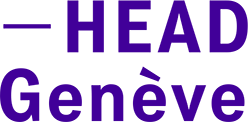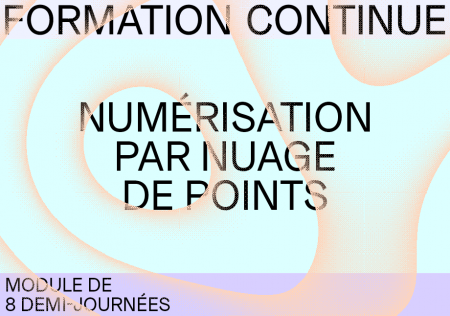- The school
- Studies and Research
- BACHELOR
- MASTER
- DOCTORATE
- RESEARCH
- TRANSDISCIPLINARITY
- POOLS
- CONTINUING EDUCATION
- Continuing education 2025-2026
- Artificial Intelligence, initiation
- Artificial Intelligence, Advanced
- Artificial intelligence open-source, ComfyUI
- Creative coding
- Engage with drawing
- Frame-by-frame animation
- 3D exhibition modeling in SketchUp
- 3D modeling, Blender
- Point cloud scanning
- Documentary podcast
- Serious games
- For students
- Studying at the HEAD
- InfoLab
- Living in Geneva
- Tuition fees and sholarship
- Library
- Regulations and instructions
- Projects
- Events
- Press
- Partnerships and prizes
Point cloud scanning
Capturing objects, spaces and environments using new 3D scanning techniques and transforming them into immersive experiences.
Working with the materiality of the world, through representation, is a constant challenge. From the renovation of buildings to the curation of an exhibition, from the shooting of a film to the safeguarding of cultural heritage, point cloud scanning, or 3D scanning, has become an essential tool for capture and representation.
This course explores different methods of three-dimensional digitization, from manual reproduction from photos, to Gaussian Splatting, to terrestrial LIDAR scanning. Participants will familiarize themselves with the various tools for capturing, processing and visualizing point clouds. Several workflows will be covered to guide each participant from data acquisition to reproduction in virtual, mixed or augmented reality.
This course combines theoretical discussions, technical introductions and practical field exercises, enabling participants to acquire concrete skills through individual projects and guided work sessions.
Explore the multiple possibilities offered by point cloud surveys and discover how they can combine speed of execution with unprecedented precision and quality of representation in real time.
Target audience
This course is aimed at professionals in the fields of art, design, architecture, landscape and interior architecture, heritage, culture, museography, events and digital media who wish to integrate 3D scanning and point cloud technologies into their professional practice. In particular, the course teaches how to prepare scenographies, organize exhibition displays, survey existing sites and buildings, and digitize art and design artifacts.
It is also suitable for teachers, researchers and students interested in new forms of spatial representation and immersive technologies.
Targeted skills
- Understand and become familiar with various 3D capture methods (photogrammetry, gaussian splatting, mobile LIDAR, terrestrial LIDAR)
- Understand the technical principles of point clouds and new technologies known as novel views synthesis and be able to establish an appropriate workflow
- Know how to process, clean and optimize data with specialized software
- Be able to visualize and manipulate point clouds in an open-source environment
- Learn how to publish and share 3D models via various platforms in augmented reality, virtual reality or via a web browser
- Be able to integrate these technologies into creative and professional projects
Prerequisites:
No prior technical skills are required, but familiarity with computer tools, especially 3D, is recommended. Participants must have a personal computer capable of running 3D software (8GB RAM minimum, dedicated graphics card recommended). A digital camera (dedicated or via a recent smartphone) is required for capture sessions.
Course duration: 8 half-days
Dates and schedule :
- Friday 06 March 2026 from 1:30pm to 5:00pm
- Saturday 07 March 2026 from 9:00am to 12:30pm
- Saturday 14 March 2026 from 9:00am to 12:30pm and from 13h30 to 17h00
- Friday 20 March 2026 from 1:30pm to 5:00pm
- Saturday 21 March 2026 from 9:00am to 12:30pm
- Friday 27 March 2026 from 1:30pm to 5:00pm
- Saturday 28 March 2026 from 9:00am to 12:30pm
Fee: 1200 CHF / HEAD Alumni - Geneva 900 CHF
Language: French (support in English or Italian possible)
Course format: theoretical courses, practical field sessions and technical workshops
Title issued : Attestation de formation continue
Credits: equivalent to 2 ECTS
Location: HEAD Campus, Bâtiment E, Av. de Châtelaine 5, 1203 Geneva and field trips in Geneva
See detailed program
Day 8 - Project presentation and discussion
The course alternates between theoretical presentations, technical demonstrations, field capture sessions and workshop processing sessions. Participants will familiarize themselves with the various techniques during a semi-common exercise. Group discussions and individual follow-up will enable the content to be adapted to each participant's specific needs.
Day 1 - Introduction to spatial representation and point clouds
Introduction and introduction of participants
History and theory of spatial representation
Introduction to point clouds and their application in projects
Presentation of the exercise and discussion of personal projects
Reconstructing a perspective
Day 2 - Theory and practical introduction
The different capture methods
Equipment and first manipulations
Preparing capture sessions in the field
Day 3 - Field practice I
Day 3 - Field practice I
Site visit
Preparing for capture
Capture session
Day 4 - Field practice II
Capture session
Day 5 - Data processing I
Data assembly
Personal project work
Day 6 - Data processing II
Data cleaning and representation
Work on personal projects
Day 7 - Immersive visualization
2D data visualization
Online data sharing
Immersive visualization, mixed, augmented and virtual reality, point clouds
Day 8 - Project presentation and discussion
Finalizing personal projects
Presentation of personal projects and group discussion
Future prospects
Course led by:
Damien Greder
Damien Greder is a Swiss Federal Institute of Technology architect and doctoral student in Political Science and International Relations (IHEID / HEAD - Geneva (HES-SO)). As part of his doctoral project, Political Housing: Togetherless explores the use of point clouds and 3D scanning technologies to question our relationship with the built environment, notably through immersive experiences.
Information and registration / admission
Contact: fc.head@hesge.ch
Registration form
General terms and conditions

